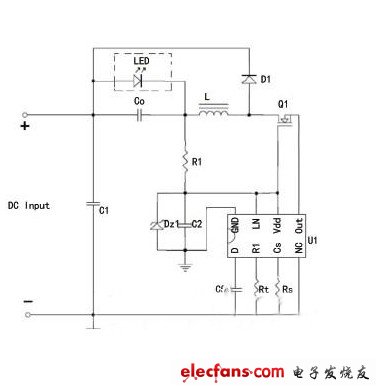The article introduces in detail the DU8608 chip based on non-isolated BUCK topology, source drive MOSFET to achieve extremely high precision LED constant current control. The test proves that the full-closed-loop TRUEC2 technology detects the real output current in real time, free from the influence of input voltage and external inductance, and breakthroughly improves the accuracy of the LED output current.
I. Introduction
According to the characteristics of LED lighting load, the topology of the current non-isolated constant current drive power supply is basically a buck step-down structure. The mainstream solution is to fix the peak current through a fixed off time to achieve a fixed output current control strategy. This article will discuss the principle of this control strategy to achieve constant current, analyze the advantages and disadvantages of this open-loop control strategy, and the external compensation required to apply this control strategy. At the same time, based on the DU8608 chip, this new closed-loop current control strategy is introduced Introduce in detail how this control strategy can breakthroughly improve the accuracy of LED output current, from open loop to closed loop is its essential breakthrough.
2. Principle and Design
2.1 Current mainstream control strategy in the field of LED non-isolated constant current drive current
As shown in Figure 1, the circuit is a BUCK buck structure, and the chip controls the source of the MOSFET. This is an open-loop constant current control method. The control principle is as follows:

When the MOSFET turns on, current flows from the DCBUS through the LED load, through the inductor, and into the ground.
Vi-Vo = Ldi / dt = L * Ir / DT (1)
When the MOSFET is turned off, the inductor current continues to flow from D1. The following formula is derived:
Vo = Ldi / dt = L * Ir / (1-D) T (2)
Io (average) = Ipk-1 / 2 * Ir (3)
From (2) and (3) Io = Vref / Rs-Vo * (1-D) T / (2 * L) (4)
Vref and Rcs are both set fixed values. Since the current flows through the LED load, if the current is fixed, the voltage Vo of the LED can be considered fixed, so it can be seen from equation (4) that as long as the inductance value L is fixed, then fixed off The off time (1-D) T, Io is fixed.
Therefore, this open-loop control strategy is that the resistance connected to Rt sets the off-time of the MOSFET. At the beginning of each cycle, the MOSFET is turned on until the inductor current rises to the peak Vref / Rs. At this time, the MOSFET is turned off, and the turn-off time is determined by Rt. After the set turn-off time, the MOSFET is turned on again, so it works again and again. The turn-off time controls the ripple current LED average current. According to the current value that you want to output, adjust the Rs value of the CS pin and adjust the Rt value. Fix the turn-off time of each switching cycle to a value, thereby achieving the output current Constant current.
This is a simple and effective control strategy, but because this is an open-loop control mode, it can only detect the peak current on the inductor, but cannot detect the output current. The accuracy of the output current is prone to deviation in three cases:
1. The input voltage fluctuates. (Open loop control, unable to feedback, caused by system delay)
2. Mass production inductance inductance deviation. (In Equation 4, the change in L causes the change in Io)
3. The LED load voltage is not the same (Vo).
4 Outlets EU Socket,EU Power Socket USB,EU Power Socket
Dongguan baiyou electronic co.,ltd , https://www.dgbaiyou.com